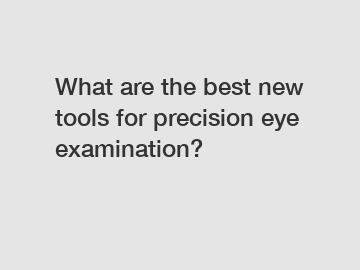What are the best new tools for precision eye examination?
Apr. 05, 2024
When it comes to eye health, precision is key. From detecting vision problems to monitoring the progression of diseases like glaucoma and macular degeneration, having the right tools for a precise eye examination is essential. Fortunately, advancements in technology have led to the development of new tools that are revolutionizing the field of optometry. In this blog, we will take a closer look at some of the best new tools for precision eye examination.
1. Optical Coherence Tomography (OCT).
One of the most important tools in modern eye care is Optical Coherence Tomography (OCT). This non-invasive imaging technique allows eye care professionals to obtain high-resolution, cross-sectional images of the retina. OCT is particularly useful for diagnosing and managing conditions such as age-related macular degeneration, diabetic retinopathy, and glaucoma.

With its ability to provide detailed images of the layers of the retina, OCT allows for early detection of disease progression and more precise monitoring of treatment outcomes. This technology has revolutionized the way eye care professionals assess and manage their patients’ eye health.
2. Fundus Photography.
Fundus photography is another essential tool for precision eye examination. By capturing detailed images of the back of the eye, including the retina, optic disc, and blood vessels, fundus photography helps eye care professionals detect and monitor a variety of eye conditions. These include diabetic retinopathy, macular degeneration, and retinal detachments.
The high-quality images produced by fundus photography can be used to track changes in the eye over time, allowing for more accurate diagnosis and treatment planning. This technology is especially useful for monitoring the progression of diseases that affect the retina and optic nerve.
3. Automated Refractors.
Automated refractors are another valuable tool for precision eye examination. These devices use advanced technology to measure the refractive error of the eye, including nearsightedness, farsightedness, and astigmatism. By providing accurate measurements quickly and efficiently, automated refractors help eye care professionals determine the most appropriate prescription for their patients.
With automated refractors, eye exams are streamlined, reducing the margin for error and ensuring that patients receive the most accurate prescription possible. This technology is especially helpful for children and patients who have difficulty communicating their visual needs.
4. Corneal Topography.
Corneal topography is a tool that maps the surface of the cornea, the transparent outer layer of the eye. By analyzing the shape and curvature of the cornea, eye care professionals can identify irregularities that may affect vision and overall eye health. Corneal topography is particularly useful for diagnosing conditions such as keratoconus and assessing the fit of contact lenses.
With corneal topography, eye care professionals can customize treatment plans to address the specific needs of each patient. This technology allows for more precise measurements and better outcomes for patients with corneal irregularities.
5. Intraocular Pressure Measurement.
Intraocular pressure measurement is a critical component of a comprehensive eye examination, especially for patients at risk of developing glaucoma. Elevated intraocular pressure can damage the optic nerve and lead to vision loss if left untreated. Therefore, it is essential to monitor this pressure regularly to detect changes that may indicate the presence of glaucoma.
Tools such as tonometers are used to measure intraocular pressure accurately and efficiently. These devices help eye care professionals identify patients who may be at risk of developing glaucoma and provide appropriate treatment to preserve their vision. Intraocular pressure measurement is essential for maintaining optimal eye health and preventing vision loss.
In conclusion, the best new tools for precision eye examination are revolutionizing the field of optometry. From advanced imaging techniques like OCT and fundus photography to automated refractors and corneal topography, these tools provide eye care professionals with the information they need to deliver superior care to their patients. By incorporating these cutting-edge technologies into their practice, eye care professionals can ensure accurate diagnosis, personalized treatment plans, and better outcomes for their patients. Investing in the latest tools for precision eye examination is essential for maintaining optimal eye health and preserving vision for years to come.
If you want to learn more, please visit our website Retinal Camera, Laser Retinal Imaging, Eye Fundus Camera.
84
0
0


Comments
All Comments (0)